Body Alignment & Balance. Our Midline Anatomy & the Median Plane.
post by leggi · 2019-08-22T10:24:59.156Z · LW · GW · 6 commentsContents
Alignment & Balance of the Human Body. Introduction. When referring to the human body, What do balance and alignment mean? Alignment, Balance & The Median Plane. The position of the rest of the body should be considered relative to the midline anatomy and the median plane. Midline Anatomy. Palpable Anatomical Structures. Midline Linear Structures. Linea Alba. Nuchal and Supraspinous Ligaments. Increasing Conscious Awareness of Midline. Dynamic Alignment and Balance. Think about where your midline anatomy is in relation to the median plane. Feel for your state of balance and alignment. None 6 comments
Alignment & Balance of the Human Body.
Epistemic status: An introduction post for my Base-Line Theory of Human Health and Movement. Facts and definitions first ...
Introduction.
When referring to the human body,
What do balance and alignment mean?
Two (of the many) definitions for balanced:
1. Different parts of something that exist in equal or correct amounts.
2. A state of equilibrium, being in harmonious arrangement.
Alignment has many definitions, the two most relevant to 'body alignment' are:
1. Arrangement in a straight line.
2. Arranged in the correct relative positions.
Alignment, Balance & The Median Plane.
The median plane (a.k.a. midsagittal plane) is the plane that splits the body into left and right halves.
A straight line when viewed from the front or back. A 2-D shape from the side.
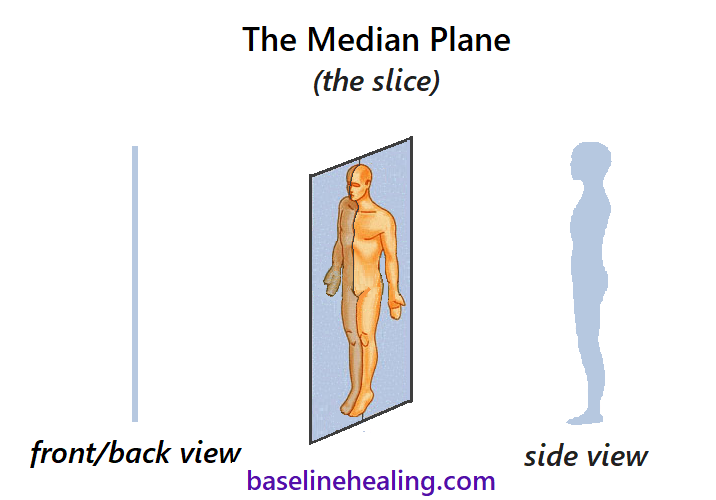
The body must be "correctly arranged" to create the median plane, where:
- The body is aligned.
- All midline anatomy is arranged on the straight line of the median plane.
- The body is balanced.
- Left and right sides in equilibrium either side of the median plane.
The position of the rest of the body should be considered relative to the midline anatomy and the median plane.
Midline Anatomy.
Palpable Anatomical Structures.
Some easy to find midline anatomical structures include the:
- Anus. (asshole)
- Pubic symphysis [LW · GW] of the pelvis. (bone between the legs, front midline)
- Navel [LW · GW]. (belly button)
- Xiphoid process [LW · GW] of the sternum. (inverted "V" bottom of rib cage, front midline)
- Jugular notch [LW · GW] of the sternum. ( "V" top of rib cage, front midline)
- External occipital protuberance [LW · GW]. (back of head - midline bump at the base of the skull).
Feel for the relative positioning of these midline markers to increase your awareness of your body's midline.
Midline Linear Structures.
The linear anatomical structures on our midline need to be at full extension to be truly aligned - straight, smooth, no kinks or tensions so they can line up on the median plane.
The main linear structures we should focus on for body alignment are:
- The linea alba. Midline at the anterior (front) of the body.
- Our primary anatomical guide for body alignment.
- The nuchal ligament & supraspinous ligament. Forming a continuous structure midline at the posterior (back) of the body.
- Our secondary anatomical guides for body alignment.
Linea Alba.
The linea alba (Latin for 'white line') is a strip of strong connective tissue [LW · GW] midline at the front of the abdomen.
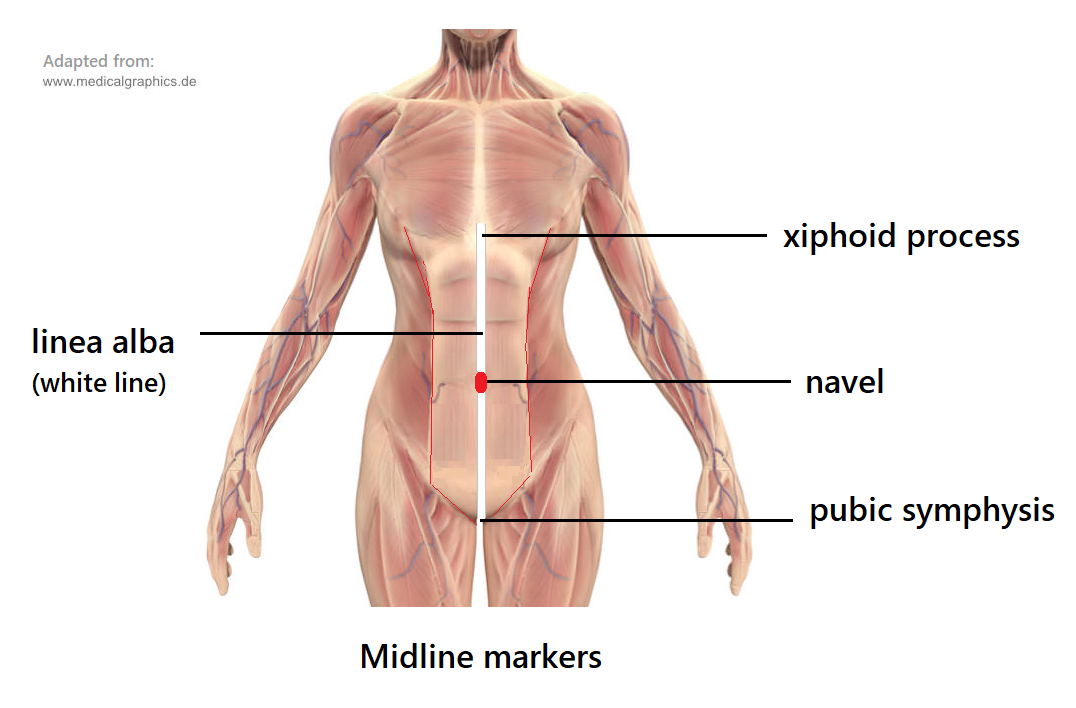
One end of the linea alba attaches to the pubic symphysis of the pelvis and the other end to the xiphoid process of the sternum with the navel situated in the middle.
The linea alba is formed from the aponeuroses (tough, thin sheets of connective tissue) of the three lateral abdominal muscles (the muscles that wrap around the sides of the abdomen - the external abdominal oblique, internal abdominal oblique and transversus abdominis) as left and right sides fuse at the front of the abdomen.

Before the aponeuroses of the lateral abdominal muscles merge at the linea alba they form the left and right rectus sheaths (tunnels of connective tissue) in which the corresponding left and right rectus abdominis muscles lie (like a ribbon in a sheath either side of midline).
The rectus abdominis [LW · GW] muscles are the closest muscular tissue to the linea alba, lying either side from pelvis to chest and are the key muscles to focus on to become aware of the relative alignment of the linea alba.

The linea alba and rectus abdominis muscles all originate from the pubic symphysis.
Nuchal and Supraspinous Ligaments.
The nuchal ligament (ligamentum nuchae) and supraspinous ligament are one continuous structure at the posterior of the spine, a long strip of tough connective tissue from "head to tail".
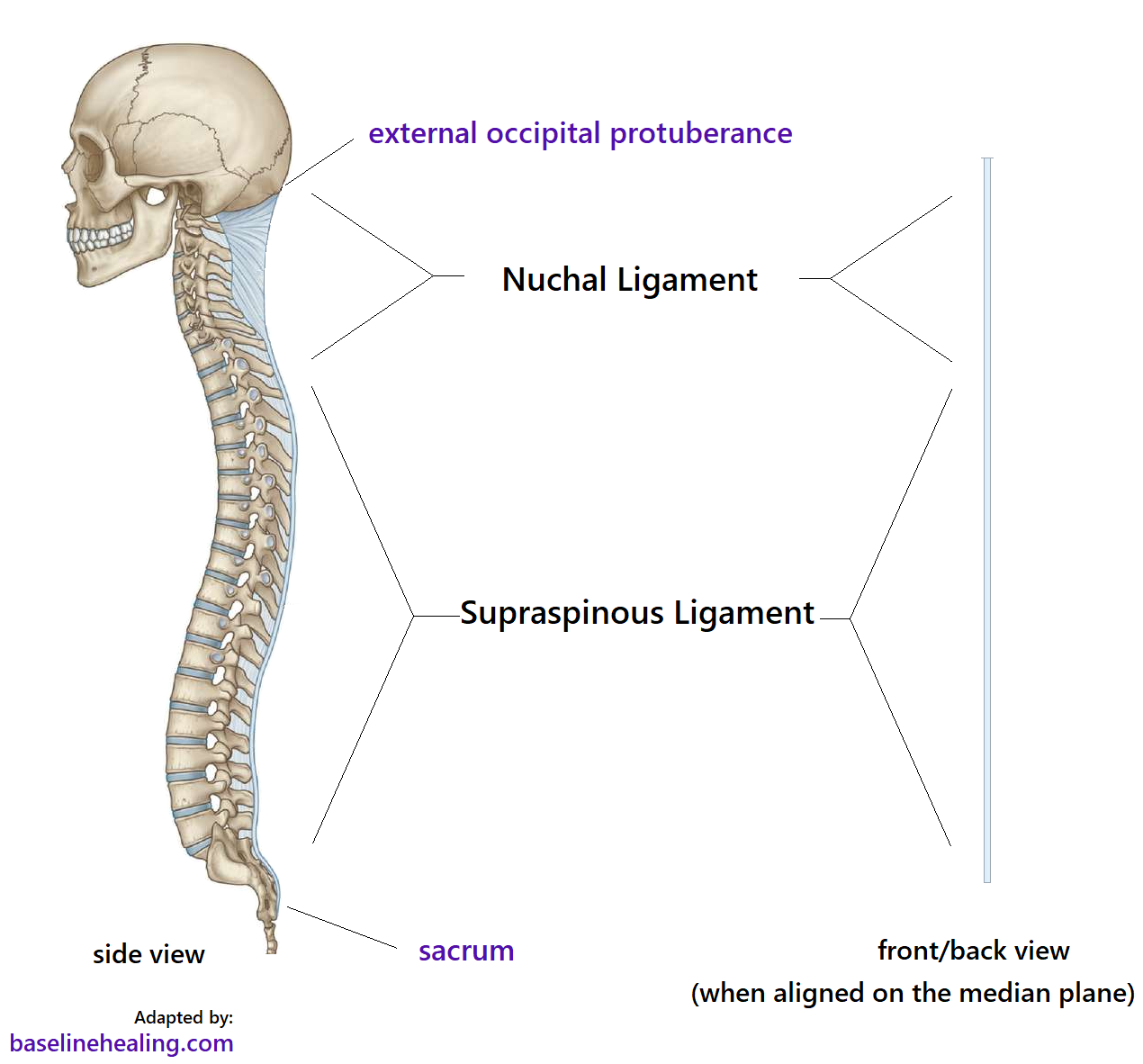
The nuchal ligament is a septum (dividing wall) midline in the back of the neck. It consists of fibro-elastic connective tissue i.e. it is strong with elastic properties.
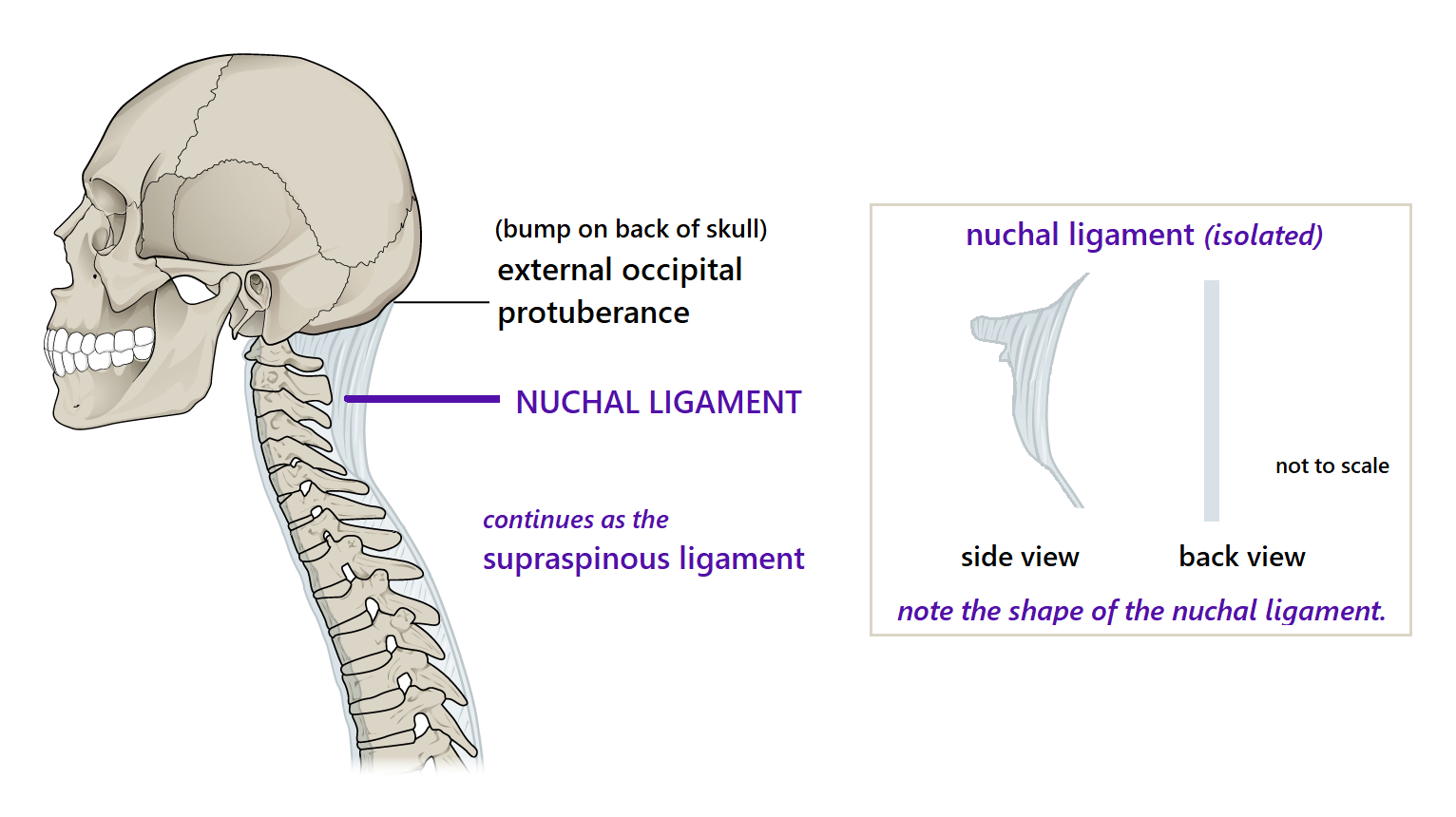
The nuchal ligament attaches to the base of the skull at the external occipital protuberance (feel for the midline bump at the back of the skull) and the medial nuchal line (a.k.a. the external occipital crest).
The nuchal ligament then attaches to the spinous processes of all the cervical vertebrae. At the 7th (last) cervical vertebra, the nuchal ligament continues as the supraspinous ligament, a strong, fibrous cord attaching to the spinous processes of the seventh cervical vertebra, all twelve thoracic vertebrae and the upper lumbar vertebrae, usually terminating at the 4th lumbar vertebra (but possibly L3 or L5).
The left and right trapezius [LW · GW] muscles attach to the nuchal and supraspinous ligaments from the base of the skull to the last thoracic vertebra. The trapezius muscles are key to feeling and controlling the positioning of the nuchal and supraspinous ligaments.

Unimportant to my theory, I mention it now to be complete: The anterior longitudinal ligament is the longest anatomical structure on the midline. Running the entire length of the spine and attaching to the anterior (front) of each vertebrae, it cannot be 'felt', either by palpation or by focusing on adjacent muscles.
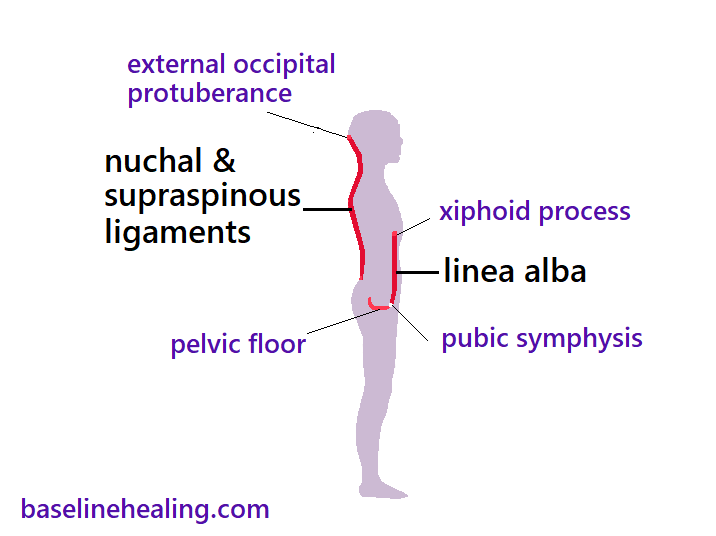
Increasing Conscious Awareness of Midline.
To increase conscious awareness of our midline we can tap into the proprioceptive feedback (sensory information regarding positioning, motion and balance) generated by various structures by actively focusing on them.
Muscles and other structures that are on, or either side of, midline include:
- The pelvic floor [LW · GW] muscles. A group of muscles forming a 'basket' at the base of the linea alba.
- Perineal muscles. Anal sphincter.
- The clitoris/suspensory ligament of the penis located at the pubic symphysis.
- The rectus abdominis [LW · GW] muscles either side of the linea alba.
- The trapezius [LW · GW] muscles attaching to the nuchal and supraspinous ligaments.
Much information about the relative positioning the head can be gained from:
- Nostrils. Feel the air flow in each nostril, aiming for balance.
- Movement of the mouth, lips and jaw.
- The tongue. Positioning the tongue behind the central incisors and on the hard palate provides sensory feedback about midline.
Dynamic Alignment and Balance.
The body is not static. We are constantly on the move and thus true balance and alignment are dynamic states.
The body is aligned when:
- Our midline anatomy can be at maximal extension on the median plane.
- The body balanced either side of the median plane.
- Midline anatomical structures are positioned in the correct relative positions to allow a full range of natural movement. [LW · GW]
- The body is stable.
- Movement is fluid.
- The body is free of physical restrictions [LW · GW] that would otherwise apply tensions and restrict range of movement.
The linea alba, nuchal and supraspinous ligaments are like a ribbon/ rope/band that can bend and twist at every level, supporting the rest of the body when we have a full range of natural movement.
Think about where your midline anatomy is in relation to the median plane.
Feel for your state of balance and alignment.
BaseLineHealing.com the median plane. linea alba. nuchal & supraspinous ligaments.
6 comments
Comments sorted by top scores.
comment by Richard_Kennaway · 2019-10-17T10:33:14.314Z · LW(p) · GW(p)
Thank you for writing this series (which somehow I missed seeing when it first appeared). There has been a fair amount posted on nutrition in the past, on the grounds that the better you make your body work, the better the mind within it will work. Mens sana in corpore sano. So material like this on how to use the body is every bit as relevant here, and the subject has previously not much been discussed. To have a body which simply does what you ask of it is a wonderful thing, and supports a mind that does likewise.
Replies from: leggi↑ comment by leggi · 2019-10-19T06:11:48.121Z · LW(p) · GW(p)
Thanks for the comment, it's nice to know my posts are getting read.
My mind is definitely calmer and clearer (and life much less stressful) now that my body is more aligned.
I'd love to comment on your qualia of consciousness thread but I'm not ready - many thoughts are floating round but I can't quite grasp them to turn them into a coherent presentation. Although developing my conscious proprioceptive skills has definitely increased my awareness of myself. I'm fairly confident I exist these days!
comment by habryka (habryka4) · 2019-08-22T19:31:32.126Z · LW(p) · GW(p)
This post seems potentially interesting, but I think I am missing a hook on why I should care about the content of this post. Is there a particular reason to care about the alignment of my body? What benefits would I gain from it? Is there a relevance to rationality and the art of thinking?
Replies from: leggi, leggi↑ comment by leggi · 2019-08-23T09:34:36.252Z · LW(p) · GW(p)
Art of thinking? - If that means thinking about things, then this is something to think about... (and the sources of all the information needed are within easy reach.) Relevance to rationality? - As the start of a logical progression to explain my beliefs, then yes... This is the root that will develop several branches, but it needs time to grow.
I have multiple possible hooks, but they're all jumping to my conclusions - "facts" first.
Why should your care about your alignment and balance (there's a ding ding ding we have a winner for "bits that bother me" in my head). I believe you should, and that the alignment of the body (and a full range of movement) is important to health, but what 'evidence' do I have of that?
- My personal opinion that balance and alignment sound good qualities.
- My personal experience - but I'm just a random on the internet, so there's little point to expanding on that, at least until the groundwork is laid.
- Many physical disciplines go on about balance and alignment - a common phase in some circles - but I've little experience in such disciplines so can't comment on that!
So nothing that should be convincing, but balance and alignment sound good don't they? :)
I am hoping for feedback about what balance and alignment mean to others. I'm in my own little micro-bubble (a true believer) and would be interested in other perspectives.
Ultimately, this is a journey from " fact" to "feeling". My next post will expand on the muscular anatomy of balance and alignment, and include my thoughts on that anatomy. How to start to feel your alignment...
↑ comment by leggi · 2019-10-31T08:30:10.732Z · LW(p) · GW(p)
My first hook: pains of an imbalanced body [LW · GW].
A rational explanation for so much pain that many people seem to have?
All the anatomy is in my first two posts. All that is required is the consideration of that anatomy. Find the muscles, feel for them working.
I'm hoping the demographic of LW means there's enough fairly healthy subjects that are both logical and curious in their thinking to spend a little time thinking about how their own body works. The benefits are worth it!
comment by peer · 2023-12-29T20:40:44.234Z · LW(p) · GW(p)
I spent a lot of time trying to integrate "anatomy trains" and various other resources on posture and muscular/skeletal alignment, but nothing has been easier or more applicable than this post. Thank you leggi.
I agree that this sort of alignment has far greater impact on the mind and its well being than most (even those suffering from Firbo and similar) will admit.
I'll be sharing this with friends and am eager to see how they respond.